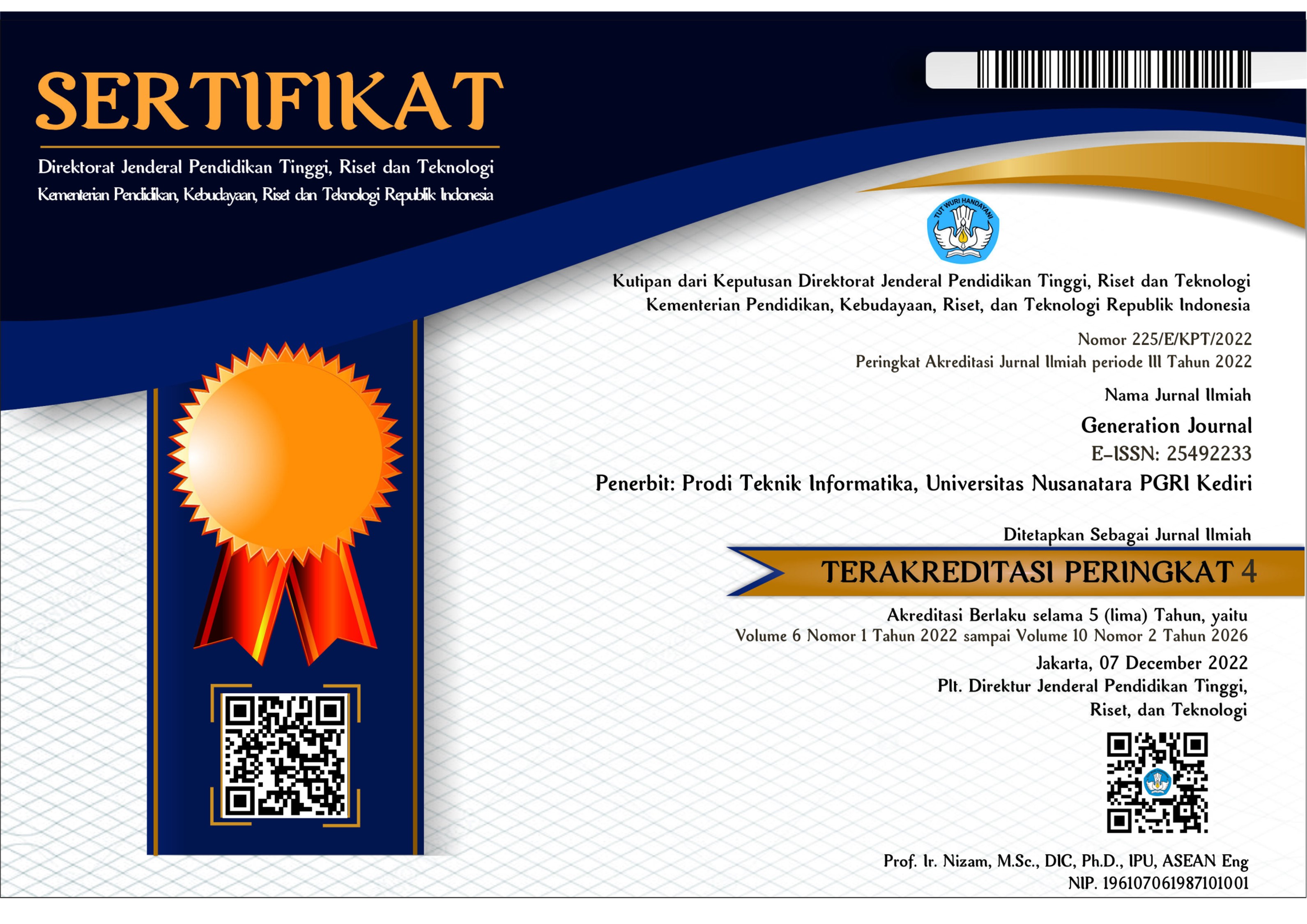Prototype of IoT Application for Monitoring Street Lighting by Utilizing Solar Power
DOI:
https://doi.org/10.29407/gj.v9i2.25694Keywords:
Monitoring lampu jalan, Esp32, Internet of Things (IoT)Abstract
Street lighting plays a vital role in ensuring the safety and comfort of road users, especially at night. Manual monitoring of streetlights is considered inefficient as it requires significant time and effort. This study proposes an automatic monitoring system based on the Internet of Things (IoT) to enhance the effectiveness of streetlight supervision. The system is built using an ESP32 microcontroller integrated with a current sensor, voltage sensor, and light sensor (LDR). The device connects to the internet and transmits data in real-time to a cloud-based platform, where it is visualized on a monitoring dashboard. Test results show that the system can accurately detect the on/off status of the lights, with LDR readings ranging from 0 to 4045, current sensor showing 0.2 amperes, and voltage sensor recording 7.4 volts. Additionally, the system can automatically control the relay to switch the lights on or off based on sensor input. Overall, the proposed system improves the efficiency of monitoring, enables faster detection of lighting conditions, and supports more timely and energy-efficient maintenance of street lighting infrastructure
References
A. Adam, M. Muharnis, A. Ariadi, and J. Lianda, “Penerapan IoT untuk Sistem Pemantauan Lampu Penerangan Jalan Umum,” Elinvo (Electronics, Informatics, Vocat. Educ., vol. 5, no. 1, pp. 32–41, 2020, doi: 10.21831/elinvo.v5i1.31249.
T. E. Achar, C. Rekha, and J. Shreyas, “Smart automated highway lighting system using IoT: a survey,” Energy Informatics, vol. 7, no. 1, 2024, doi: 10.1186/s42162-024-00375-7.
Mila Ilieva-Obretenova and Radi Pipev, “IoT Management for Street Lighting—Information Model—Part II,” Manag. Stud., vol. 11, no. 5, pp. 253–261, 2023, doi: 10.17265/2328-2185/2023.05.002.
D. T. Listrik, F. Vokasi, U. N. Surabaya, D. T. Listrik, F. Vokasi, and U. N. Surabaya, “Rancang Bangun Sistem Kontrol dan Monitoring Lampu Penerangan Jalan Umum ( PJU ) Menggunkan Yolo dan Node-red Achmad Malikur Robbani Musthofa Widi Aribowo , Reza Rahmadian , Ayusta Lukita Wardani,” pp. 95–101, 2020.
A. A. Hidayah, “Monitoring Arus Dan Tegangan Pada Pengisian Lampu Penerangan,” vol. 18, no. I, pp. 48–54, 2025, doi: 10.5281/zenodo.15052833.
Q. Hidayati, N. Jamal, N. Yanti, and Y. Tri Prasetyo, “Sistem monitoring dan kontrol penerangan jalan umum tenaga surya berbasis Internet of Things,” JITEL (Jurnal Ilm. Telekomun. Elektron. dan List. Tenaga), vol. 3, no. 1, pp. 19–26, 2023, doi: 10.35313/jitel.v3.i1.2023.19-26.
F. O. Dayera, Musa Bundaris Palungan, “G-Tech : Jurnal Teknologi Terapan,” G-Tech J. Teknol. Terap., vol. 8, no. 1, pp. 186–195, 2024, [Online]. Available: https://ejournal.uniramalang.ac.id/index.php/g-tech/article/view/1823/1229
[M. A. Prasetyo and H. K. Wardana, “Rancang Bangun Monitoring Solar Tracking System Menggunakan Arduino dan Nodemcu Esp 8266 Berbasis IoT,” Resist. (Elektronika Kendali Telekomun. Tenaga List. Komputer), vol. 4, no. 2, p. 163, 2021, doi: 10.24853/resistor.4.2.163-168.
I. Ihsan and A. wahyu Aditya, “Rancang Bangun Battery Monitoring System (BMS) berbasis LabVIEW,” JTT (Jurnal Teknol. Terpadu), vol. 9, no. 1, pp. 44–49, 2021, doi: 10.32487/jtt.v9i1.972.
M. T. Setiawan, I. Winarno, and B. Y. Dewantara, “Implementasi Internet Of Things Dalam Rancang Bangun Sistem Monitoring Pada Solar Cell Berbasis Web,” JEECOM J. Electr. Eng. Comput., vol. 3, no. 1, pp. 34–38, 2021, doi: 10.33650/jeecom.v3i1.1981.
A. Mubarak ’aafi, J. Jamaaluddin, and I. Anshory, “Implementasi Sensor Pzem-017 Untuk Monitoring Arus, Tegangan dan Daya Pada Instalasi Panel Surya dengan Sistem Data Logger Menggunakan Google Spreadsheet dan Smartphone,” SNESTIK Semin. Nas. Tek. Elektro, Sist. Informasi, dan Tek. Inform., p. 191, 2022, [Online]. Available: https://ejurnal.itats.ac.id/snestikdanhttps://snestik.itats.ac.id
S. Sintaro, A. Surahman, and C. A. Pranata, “Sistem Pengontrol Cahaya Pada Lampu Tubular Daylight Berbasis Iot,” J. Teknol. dan Sist. Tertanam, vol. 2, no. 1, p. 28, 2021, doi: 10.33365/jtst.v2i1.1034.
A. Manik Dirgayusari and I. W. Sudiarsa, “Implementasi Sistem Monitoring dan Kontrol Suhu Kelembaban Ruang Budidaya Jamur Berbasis IoT,” J. Sist. Inf. dan Komput. Terap. Indones., vol. 4, no. 2, pp. 78–89, 2021, doi: 10.33173/jsikti.127.
E. V. Haryanto and R. Puspasari, “Rancang Bangun Monitoring Penerangan Ruangan Menggunakan Kamera Berbasis Komputer Dengan Metode Fuzzy Logic,” It (Informatic Tech. J., vol. 4, no. 2, p. 192, 2017, doi: 10.22303/it.4.2.2016.192-201.
M. Tinambunan and S. Sintaro, “Aplikasi Restfull Pada Sistem Informasi Geografis Pariwisata Kota Bandar Lampung,” J. Inform. dan Rekayasa Perangkat Lunak, vol. 2, no. 3, pp. 312–323, 2021, doi: 10.33365/jatika.v2i3.1230.
Downloads
Published
Issue
Section
License
Copyright (c) 2025 Fattah Satrio Atmojo, Nurchim, Pramono

This work is licensed under a Creative Commons Attribution-ShareAlike 4.0 International License.
Authors who publish with this journal agree to the following terms:
- Copyright on any article is retained by the author(s).
- The author grants the journal, the right of first publication with the work simultaneously licensed under a Creative Commons Attribution License that allows others to share the work with an acknowledgment of the work’s authorship and initial publication in this journal.
- Authors are able to enter into separate, additional contractual arrangements for the non-exclusive distribution of the journal’s published version of the work (e.g., post it to an institutional repository or publish it in a book), with an acknowledgment of its initial publication in this journal.
- Authors are permitted and encouraged to post their work online (e.g., in institutional repositories or on their website) prior to and during the submission process, as it can lead to productive exchanges, as well as earlier and greater citation of published work.
- The article and any associated published material is distributed under the Creative Commons Attribution-ShareAlike 4.0 International License













